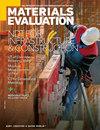涡流检测的基础与创新
IF 0.3
4区 材料科学
Q4 MATERIALS SCIENCE, CHARACTERIZATION & TESTING
引用次数: 1
摘要
涡流测试被认为是一种理论上具有挑战性的技术。在所有不同的无损检测方法中,电磁检测(ET)方法(其中涡流检测是一种技术)可能是最难以理解的理论。这也许就是为什么最后一篇关于涡流测试的材料评估回归基础的论文是在2006年发表的,考虑到自那以后技术上的大量创新,这是很久以前的事情了(Hansen and Peoples 2006)。在本文中,我们将展示由于最近的创新而发生的变化。我们将首先介绍物理,然后解释现代设备如何帮助用户区分不同的物理现象。虽然本文是关于传统的涡流测试,但我们也会提到一些其他的ET技术及其优缺点。本文章由计算机程序翻译,如有差异,请以英文原文为准。
Eddy Current Testing Basics and Innovation
Eddy current testing is considered a theoretically challenging technique. Out of all the different nondestructive testing (NDT) methods, the electromagnetic testing (ET) method (of which eddy current testing is a technique) is probably the most difficult for understanding theory. This is perhaps why the last Materials Evaluation Back to Basics paper on eddy current testing is from 2006, which is a long time ago given the amount of innovation in the technique that has taken place since then (Hansen and Peoples 2006). In this paper we will show what has changed due to recent innovations. We first will present the physics, and then explain how modern equipment assists the user in distinguishing between different physical phenomena. Although this paper is on conventional eddy current testing, we will also mention some other ET techniques along with their advantages and disadvantages.
求助全文
通过发布文献求助,成功后即可免费获取论文全文。
去求助
来源期刊

Materials Evaluation
工程技术-材料科学:表征与测试
CiteScore
0.90
自引率
16.70%
发文量
35
审稿时长
6-12 weeks
期刊介绍:
Materials Evaluation publishes articles, news and features intended to increase the NDT practitioner’s knowledge of the science and technology involved in the field, bringing informative articles to the NDT public while highlighting the ongoing efforts of ASNT to fulfill its mission. M.E. is a peer-reviewed journal, relying on technicians and researchers to help grow and educate its members by providing relevant, cutting-edge and exclusive content containing technical details and discussions. The only periodical of its kind, M.E. is circulated to members and nonmember paid subscribers. The magazine is truly international in scope, with readers in over 90 nations. The journal’s history and archive reaches back to the earliest formative days of the Society.
 求助内容:
求助内容: 应助结果提醒方式:
应助结果提醒方式:


